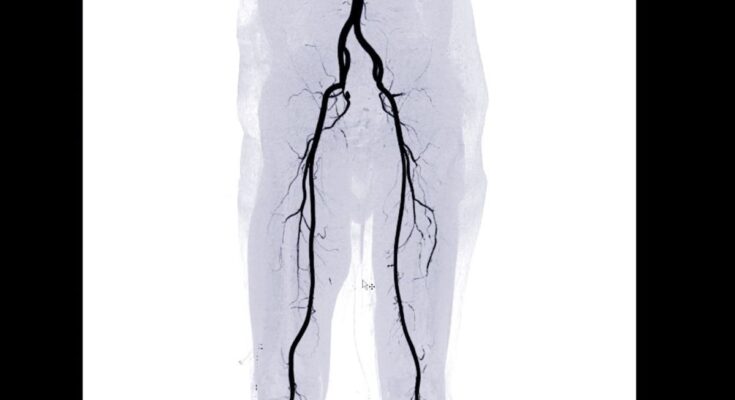Published on
Updated
The main vessel of the leg, the femoral artery supplies the thigh and the knee. What is the anatomical course of this artery? What pathologies are likely to hinder its proper functioning? Explanations from Dr François Diévart, cardiologist in Dunkirk.
Where is the femoral artery located?
Anatomically, the femoral artery constitutes the main vessel of the thigh and goes down to the knee. “The femoral artery is very long. The abdominal aorta divides into two iliac arteries, which themselves are subdivided between two arteries, an internal branch heading towards the pelvis, while the external branch continues its journey towards the leg to become the femoral artery. underlines Dr François Diévart, cardiologist in Dunkirk.
Once it crosses the crural fold, the artery changes its name and becomes the femoral artery. A few centimeters from the common femoral artery, the deep femoral artery passes along the inside of the thigh, while the superficial femoral artery runs down the length of the thigh, then passes behind the knee to become the popliteal artery. Below the knee, the artery divides again into three branches: anterior tibial artery, posterior tibial artery et the popliteal artery.
Supplying the thigh and knee area, the femoral artery can be particularly vulnerable in the event of an injury or a blow to its path.t. “A wound located in this area causes high-flow bleeding requiring emergency treatment,” explains the cardiologist.
Arteritis (or arteriopathy) of the lower limbs: a common pathology
The main problem encountered in this area remains “a sort of internal clogging” of the femoral artery by atherosclerotic plaques caused by slow exposure to toxic substances (tobacco, fats, sugar, etc.). As is the case for other arteries, the femoral artery is very sensitive to toxic substances, particularly tobacco. “The artery can become blocked at low noise. In a person with regular physical activity, small vessels will develop to bypass the narrowing area and pass through the outside. This is called collateral circulation. continues the specialist. In some people, intermittent pain when walking (intermittent claudication), particularly in the calf, may be felt. This pain should lead you to consult a doctor quickly.
What support ?
If, for other arteries, surgical intervention can be considered (bypass or angioplasty), the femoral artery lends itself less easily to surgery when a bypass must be implanted near the knee. “Indeed, the proximity of the knee can make the bypass ineffective due to plications secondary to bending the knee. In addition, there is a risk that the bypass becomes blocked, thus preventing the development of collateral circulation. explains the doctor.
Likewise, if the implantation of a stent often represents the best solution for the treatment of narrowing of the femoral artery, it must not be too long or diffuse (the artery is very long) and located not too close to the knee, because the stent could also bend under the effect of movements of the knee, and therefore potentially become blocked. “If the artery, its bypass or its stent suddenly become blocked, this can sometimes cause acute ischemia, which is very painful and disabling”, adds the cardiologist. Failing this, if the arterial narrowing (stenosis) is very localized and far from the knee and the patient has great difficulty walking, angioplasty may be considered.
In all cases, the therapeutic solution must include stopping smoking and taking care, on a medical level, of other risk factors for atherosclerosis: cholesterol, hypertension, etc. In this type of context, let us also remember that the Regular walking is essential.
An atherosclerotic plaque located on the common femoral bone does not make surgical intervention easy either. An angioplasty, which involves inserting a small spring (stent) into the artery to keep it open, may be discussed. “Placing a stent in this location is possible but not very practical due to the proximity of the hip crease.”, explains Dr François Diévart. In this case, surgeons generally prefer to opt for a thromboendariectomy (TEA) which consists of opening the artery in order to remove the limescale and cleaning this clogged area.
A pathology often more global
Very often, the problem is not only in the femoral artery, but also involves the arteries of the neck and those of the heart. The artery disease called atherosclerosis is a global disease for which comprehensive care is often necessary.
Without effective and appropriate treatment, arteritis of the lower limbs can have serious or even fatal consequences.
Unlike other arteries which may be affected by an aneurysm or dissection, these situations are very rare for the femoral artery.
It happens that chronic inflammatory diseases cause atheromatous damage in young subjects. “This is the case of Takayasu disease, for example, a very rare disease which manifests itself as inflammatory arteritis. notes Dr François Diévart. Let us also mention Buerger’s disease, another rare disease for which smoking cessation is imperative or risk very serious complications.
Femoral artery examinations
The femoral pulse can be felt at the anterior hip crease. When the artery is blocked, the pulse is usually not perceptible. “When the artery is narrowed, it is possible to feel a murmur in the artery by applying a stethoscope to it. notes the cardiologist.
As a first intention, a Doppler ultrasound remains the reference examination. However, although it makes localized images possible, this examination does not provide an overall photo of the artery. From the moment a revascularization surgical procedure, by bypass or angioplasty is considered, a CT angiogram or an MRI angiogram, or even an arteriogram, are among the examinations to be scheduled.
If he suspects arteriopathy, the doctor also prescribes a blood test (to know the cholesterol level and look for diabetes), as well as an electrocardiogram.
Unlike other arteries which may be affected by an aneurysm or dissection, these situations are very rare for the femoral artery.
As with other arterial diseases, the causes of clogging and narrowing of the arteries as well as the risk factors are identical and well known to the medical profession: smoking, excess weight, sedentary lifestyle, high blood pressure and cholesterol.
The management of femoral artery problems therefore requires global and personalized monitoring. “If illnesses become complicated in middle age, they start in youth. Hygiene-dietary rules and prevention therefore play a very important role. reminds the cardiologist.
We use DaFont for the fonts on our website. You can visit dafontfile.net for Helvetica Font, Avenir Font, Avantgarde Font, Horizon Font, Havelock Font, Racing Font, Cactus Jack Font, Roboto Font, Montserrat Font, Lato Font and Pacifico Font.
Montserrat Font
Raleway Font
Coffee Morning Sans
Horizon Font
Gotham Font Family




